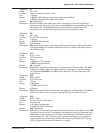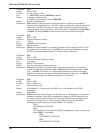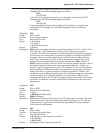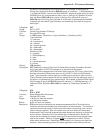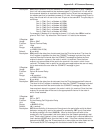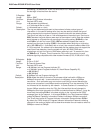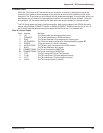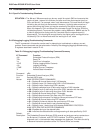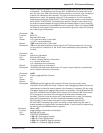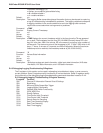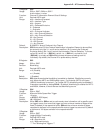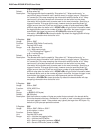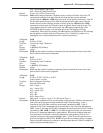
RASFinder RF300E/RF310E User Guide
RF300E/RF310E148
processing. By default the TA will not send the SETUP message until 1 second after
the last digit is received from the device.
S-Register: S89
Usage: S89=n; S89?
Function: Modem Ring/Dialtone Information
Unit: Decimal ASCII code
Range: n=0 (standard ring/dialtone),
n=1 (indicates A-law or u-law)
Default: 1 (indicates A-law or u-law)
Description: The ring and dialtone signals sent to the modems indicate various types of
information. In the case of analog calls, they may be used to indicate the type of
coding required by the modem to properly communicate with the remote modem.
The type of call may be A-law or u-law and depends on the switch type. Previous to
S89 a standard ring and dialtone were sent to the modem in which case the modem
would answer or originate the call according to its coding setting (S108=0 is u-law
and S108=1 is A-law for Lucent CSM). S89 was added to bypass the need to
manually set the type of coding (S108) in the modem when receiving or originating
calls. With S89 set to 1 (indicates A-law or u-law), then modem firmware newer than
2.10Q is required. If a modem call is attempted and the modem does not support the
new A-law/u-law detection, then the modem will print NO DIALTONE when
originating a call and it will print a RING when receiving a call. To resolve this, then
set S89=0 on all TA ports. This will cause the TA to revert to previous ring and
dialtone signaling compatible with older modem firmware (2.06I, 2.09B, and 2.10Q).
S-Register: S154
Usage: S154=n; S154?
Function: B-Channel Answer Rate
Unit: Decimal ASCII code
Range: n=0 (64Kbps, but use Progress Indicator IE),
n=1 (64Kbps, ignore Progress Indicator IE, check Bearer Capability IE),
n=56 (56Kbps),
n=64 (64Kbps)
Default: 0 (64Kbps, but use Progress Indicator IE)
Description: S154 allows the ability to force the TA to answer digital calls with a 56Kbps or
64Kbps B-channel rate. In some situations it is necessary to force a 56Kbps
connection. Such a situation may occur when a call fails to connect because the
end-to-end connection is not 64Kbps and the originating TA or the answering TA is
not infomred of this situation by the network. In some situations it is necessary to
force a 64Kbps conection when the TA is first informed that the call changed to
56Kbps but then later returned to the ISDN and switched back to 64Kbps. It may be
more likely that setting S154=1 is the best solution to the “not end-to-end ISDN”
message given by the network. In this case (S154=1), the TA will assume 64Kbps
unless the Bearer Capability Information Element indicates a 56Kbps connection.
The TA will then ignore all Progress Indicator Information Elements when S154=1.
By default the TA will check for Progress Indicator Information Elements indicating
changes in the routing of digital calls to determine whether the call needs to switch to
56Kbps or remain at 64Kbps.




